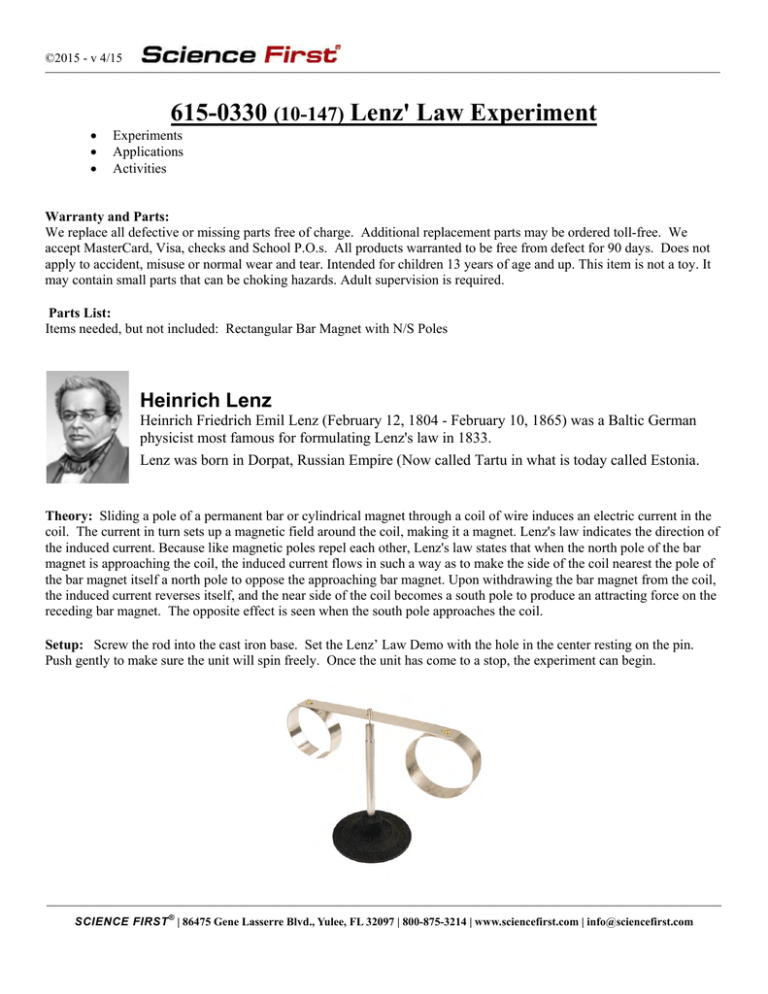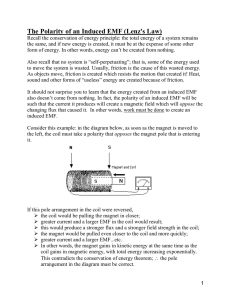615-0330 (10-147) Lenz` Law Experiment
advertisement

©2015 - v 4/15 ______________________________________________________________________________________________________________________________________________________________________ 615-0330 (10-147) Lenz' Law Experiment Experiments Applications Activities Warranty and Parts: We replace all defective or missing parts free of charge. Additional replacement parts may be ordered toll-free. We accept MasterCard, Visa, checks and School P.O.s. All products warranted to be free from defect for 90 days. Does not apply to accident, misuse or normal wear and tear. Intended for children 13 years of age and up. This item is not a toy. It may contain small parts that can be choking hazards. Adult supervision is required. Parts List: Items needed, but not included: Rectangular Bar Magnet with N/S Poles Heinrich Lenz Heinrich Friedrich Emil Lenz (February 12, 1804 - February 10, 1865) was a Baltic German physicist most famous for formulating Lenz's law in 1833. Lenz was born in Dorpat, Russian Empire (Now called Tartu in what is today called Estonia. Theory: Sliding a pole of a permanent bar or cylindrical magnet through a coil of wire induces an electric current in the coil. The current in turn sets up a magnetic field around the coil, making it a magnet. Lenz's law indicates the direction of the induced current. Because like magnetic poles repel each other, Lenz's law states that when the north pole of the bar magnet is approaching the coil, the induced current flows in such a way as to make the side of the coil nearest the pole of the bar magnet itself a north pole to oppose the approaching bar magnet. Upon withdrawing the bar magnet from the coil, the induced current reverses itself, and the near side of the coil becomes a south pole to produce an attracting force on the receding bar magnet. The opposite effect is seen when the south pole approaches the coil. Setup: Screw the rod into the cast iron base. Set the Lenz’ Law Demo with the hole in the center resting on the pin. Push gently to make sure the unit will spin freely. Once the unit has come to a stop, the experiment can begin. ______________________________________________________________________________________________________________________________________________________________________ ® SCIENCE FIRST | 86475 Gene Lasserre Blvd., Yulee, FL 32097 | 800-875-3214 | www.sciencefirst.com | info@sciencefirst.com ©2015 - v 4/15 ______________________________________________________________________________________________________________________________________________________________________ Experiment : Take your bar magnet and slide the North Pole through the closed aluminum loop. When the magnet is moved toward the loop (figure a), the induced EMF in the loop produces a current in the direction shown. When the magnet is moved back away from the loop, the induced magnetic moment attracts the bar magnet, again opposing the relative motion. If the same experiment is done with the aluminum ring that has a split completely down one side, then can a steady current be induced in the ring? No, because the ring doesn't form a complete circuit. That means that when we slide the magnet through the split ring, no current can be induced in the ring. Therefore, the ring can't produce its own magnetic field. No induced magnetic field ... no repulsion, and the ring never moves! Additional Experiment: You can try to slide items like plastic rods, wood sticks or other materials through the loops. Show that only a magnet will make the loop move. Benchmarks and Standards - This investigation provides support for the Benchmarks for Science Literacy and National Science Education Standards shown in the table below. Benchmarks for Science Literacy Grades K – 5 Physical Science Standards 4B.1 Grades 5 – 8 Physical Science Standards 4B.3 Grades 9 – 12 Physical Science Standards 4B.1 Grades K - 5 Physical Science Content Standard B.2 – Magnetism Grades 5 -8 Physical Science Content Standard B.3 – Motions and Forces, Transfer of Energy Grades 9-12 Physical Science Content Standard B.1 – Motions and Forces, Interactions of Energy and Matter ______________________________________________________________________________________________________________________________________________________________________ ® SCIENCE FIRST | 86475 Gene Lasserre Blvd., Yulee, FL 32097 | 800-875-3214 | www.sciencefirst.com | info@sciencefirst.com

